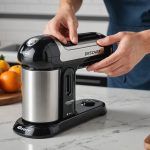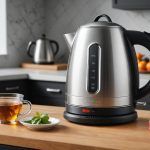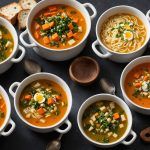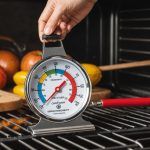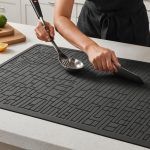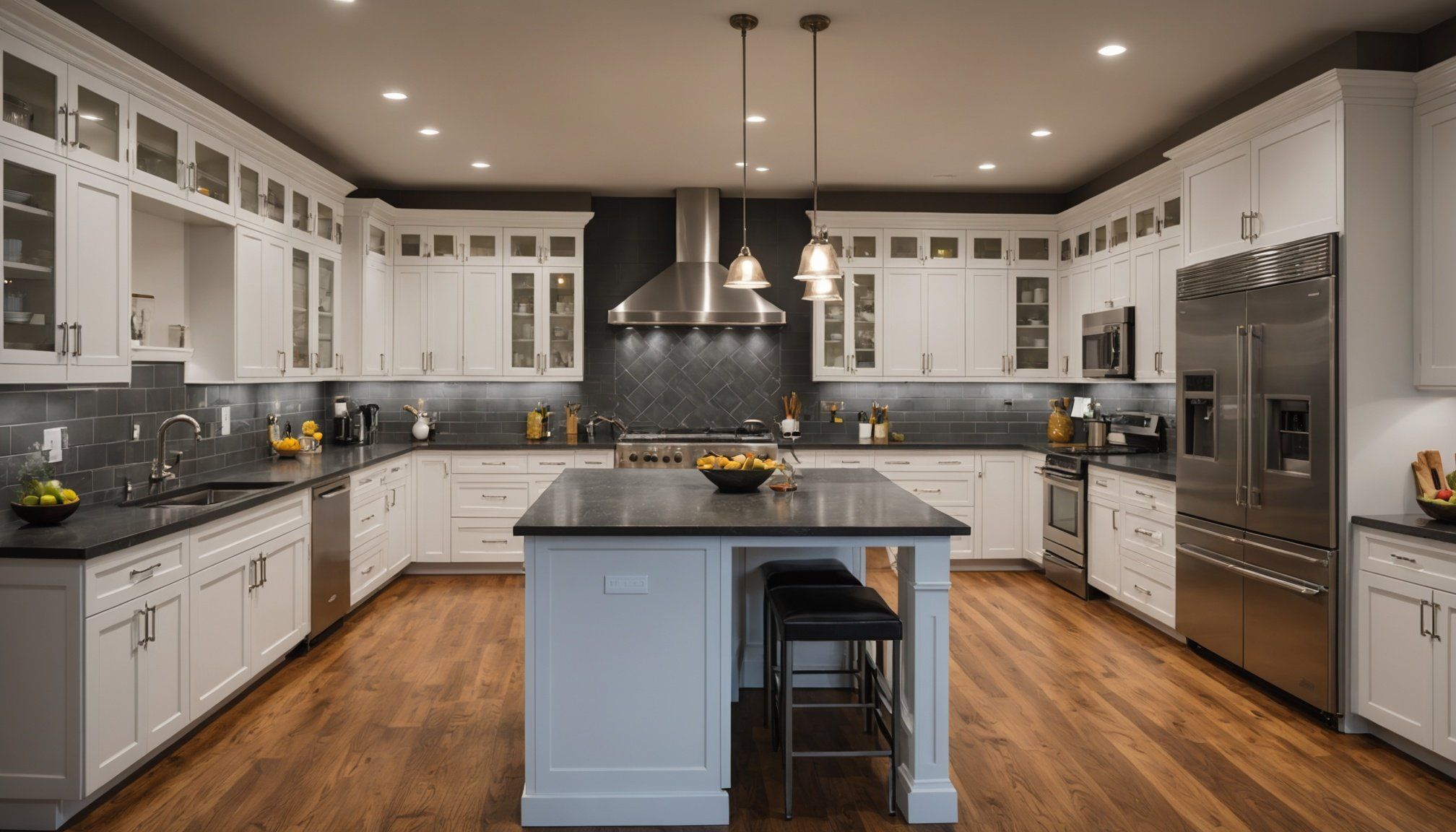Understanding the Essentials of Kitchen Design
The kitchen design fundamentals are pivotal for a space that is both aesthetically pleasing and functionally efficient. A well-thought-out design begins with an efficient layout, crucial for optimizing workflow. An efficient layout considers the “work triangle,” consisting of the stove, refrigerator, and sink. This concept ensures that movement between these essential components is seamless, minimizing effort and time.
Workflow optimization in kitchen design significantly affects cooking efficiency. Imagine repeatedly walking from one end of the kitchen to the other while preparing a meal; this can be a frustrating experience. A well-designed kitchen layout reduces unnecessary steps and allows cooks to focus on preparing delicious meals without distraction.
Also to read : Revamp your contemporary kitchen with a chic coffee roasting station: essential tips for seamless integration
For those who enjoy batch cooking, considerations differ slightly. Ample counter space becomes essential for preparing large quantities of food. Additionally, having accessible storage solutions and organizing kitchen tools and ingredients play a crucial role in supporting batch cooking needs. Thus, kitchen designs focusing on these aspects can make batch cooking more manageable and enjoyable.
In conclusion, whether you’re a casual cook or a batch cooking enthusiast, understanding these fundamental concepts is key to a functional and efficient kitchen space.
Also read : Revitalize your kitchen: smart design strategies to inspire healthy eating habits
Layout Strategies for Batch Cooking
Creating a functional kitchen layout is vital for efficient batch cooking. Employing effective strategies can enhance your cooking experience and reduce time spent in the kitchen.
The Work Triangle Concept
Central to kitchen layout strategies is the work triangle concept. This principle involves positioning the sink, stove, and refrigerator in a triangular configuration. This arrangement minimizes unnecessary movement, making it easier and faster to navigate between these key areas. A well-designed work triangle ensures a smooth workflow, reducing fatigue during extensive cooking sessions.
Zoning and Workstation Organization
Organizing your kitchen into specific zones boosts efficiency. Designate areas for preparation, cooking, and cleaning. For instance, placing a chopping board and knife rack near the refrigerator can streamline the prep zone. Meanwhile, keeping utensils, spices, and pots close to the stove in the cooking zone enhances accessibility. An ergonomic design tailored to your needs prevents clutter and confusion, helping maintain focus and productivity.
Open vs. Closed Layouts
Choosing between open and closed layouts depends on personal preference and space available. Open layouts encourage social interaction but may lack privacy and can be prone to distractions. Conversely, closed layouts offer privacy and less noise, though they might feel constrictive. Balancing between these layouts ensures the smooth operation of the work triangle while also meeting specific needs of batch cooking enthusiasts.
Organizing Your Kitchen for Maximum Efficiency
Creating a well-organized kitchen involves integrating efficient storage solutions and focusing on space optimization. This enables easy access to culinary tools and ingredients.
Pantry Setup and Storage Ideas
Designing a functional pantry is paramount when aiming for efficiency in the kitchen. Begin by sorting items according to their use and frequency. Position frequently used ingredients at arm’s reach, and seldom-used, bulk items at higher or lower shelves. Consider using clear containers with labels for better visibility and organization.
Utilizing Vertical Space
Utilizing vertical space can dramatically enhance kitchen organization. Install wall-mounted racks for spices and condiments to free up counter space. Vertical dividers in cabinets can house baking sheets and cutting boards, minimizing clutter. Opt for hanging pots and pans to save on storage solutions, maximizing every available inch of kitchen real estate.
Tools and Equipment for Batch Cooking
Batch cooking can be simplified with essential tools. Invest in a set of high-quality storage containers to store cooked meals efficiently. A sizable, versatile Dutch oven is invaluable for preparing large food batches. Additionally, a food processor and slow cooker are ideal gadgets to expedite meal preparation, bolstering your kitchen’s efficiency.
Real-Life Examples of Successful Batch Cooking Kitchens
Exploring practical implementations of batch cooking in various kitchens can provide valuable insights. These examples highlight design inspiration and kitchen case studies that cater to different needs.
Case Study: A Family-Friendly Kitchen
A family-oriented kitchen focuses on integrating space for every family member. Design inspiration includes accessible shelving for ingredients, wide countertops for meal prep, and efficient storage solutions. Utilizing durable materials ensures that the space withstands heavy use, catering to the needs of a bustling family life.
Case Study: A Professional Chef’s Workspace
Efficiency is key in a professional chef’s kitchen. Features like open shelving for easy access to ingredients, multiple cooking stations, and superior ventilation play crucial roles. This setup prioritizes speed and functionality, proving how practical implementations of professional design can optimize meal preparation.
Case Study: A Minimalist Approach
A minimalist kitchen reduces clutter and enhances space. By incorporating sleek surfaces and discreet storage, this design is as much about aesthetics as it is about functionality. The benefits of minimalism include a clutter-free environment, making room for efficient batch cooking and easy cleaning. The fewer distractions, the quicker the cooking process can be.
Technology and Innovations in Kitchen Design
The kitchen, often considered the heart of the home, is undergoing a remarkable transformation driven by smart kitchen technology and innovative appliances. These advancements are reshaping the way we approach cooking, making it more efficient and enjoyable.
Smart Appliances for Batch Cooking
Batch cooking is simplified with the latest smart appliances. Designed to enhance performance, these devices come with features that streamline processes. Imagine a smart oven that remembers your favourite settings or a refrigerator that alerts you before ingredients run out. These appliances not only save time but also minimise waste, making bulk cooking easier and more intuitive than ever.
Integration of Technology in Kitchen Design
Integrating technology into kitchen design involves more than just gadgets. It’s about creating a seamless experience where form meets function. From voice-controlled lights to touchscreen countertops, innovation plays a crucial role. These elements work together to create a space that is as smart as it is stylish, ensuring the kitchen meets modern needs effectively.
Future Trends in Kitchen Layouts
Looking ahead, emerging trends in kitchen layouts focus on efficiency and adaptability. Expect multifunctional spaces and modular designs that cater to various cooking styles. As technology advances, kitchens are likely to become more personalised, offering custom solutions to fit individual lifestyles and preferences.
Understanding Batch Cooking Needs
Batch cooking is a culinary strategy that can significantly enhance your kitchen efficiency. It involves preparing larger quantities of meals in advance, which can save time, reduce stress, and ensure healthier eating habits. Understanding your personal cooking needs and preferences is crucial. Do you cook for a large family or prefer to meal-prep for the week? Recognising these needs will guide your batch cooking journey effectively.
Kitchen design plays a pivotal role in cooking efficiency. An optimally organised kitchen can streamline the process, making it a breeze to manage larger quantities of food. Layout factors such as counter space, appliance placement, and storage are important. Ensure your workspace supports an easy workflow from preparation to storage. For instance, a well-thought-out triangle between the fridge, stove, and sink can facilitate a smooth cooking process.
Consider the appliances and tools that suit your batch cooking style. Larger pots, skillets, and storage containers can assist in managing multiple dishes concurrently. An effective kitchen focuses on easy navigation and accessibility, ensuring that everything from utensils to ingredients is within arm’s reach. By aligning your kitchen design with your batch cooking needs, you can truly maximise efficiency and enjoy the benefits of this practical approach.
Essential Layout Elements for Batch Cooking
Creating an efficient kitchen layout is crucial when it comes to effective batch cooking. By focusing on key components, you can streamline your workflow and ensure maximum productivity. Central to this is understanding the work triangle, which facilitates a seamless interaction between the stove, sink, and refrigerator.
The work triangle is a classic design principle that helps achieve an ergonomic cooking space. Ideally, each side of the triangle should be between four and nine feet, providing ample space to move but not so much that it becomes cumbersome.
Adequate counter space is another vital element of any kitchen setup as it allows for comfortable food preparation and organization. Think about accessibility; cooking zones should be intuitively placed, with commonly used items within arm’s reach. This not only enhances efficiency but also makes your cooking experience more pleasant.
Consider these points when designing your kitchen layout for batch cooking:
- Ensure uncluttered pathways between major appliances
- Position countertops near cooking and cleaning areas
- Opt for tall cabinets for storing bulk ingredients
Adhering to these design principles will significantly enhance your kitchen’s functionality and make batch cooking a breeze!
Ideal Kitchen Zones for Batch Cooking
Creating an efficient kitchen setup is vital for successful batch cooking. Understanding how to organize kitchen zones can significantly improve both the workflow and the outcome of your culinary endeavours.
Prep Zone
The prep zone sets the stage for effective meal preparation, demanding both order and convenience. Key requirements include a spacious countertop for chopping and mixing, while essential tools like knives, cutting boards, and mixing bowls should be close at hand. An often overlooked aspect, safe and efficient ingredient storage, ensures that all fresh produce and spices are easily accessible. Properly sealed containers help maintain freshness and reduce clutter, fostering a seamless cooking experience.
Cooking Zone
In the cooking zone, strategic placement of appliances such as stoves, ovens, and microwaves maximizes functionality and convenience. For efficient multitasking, keep frequently used utensils and pots within reach to transition smoothly between dishes. Safety cannot be overstated; ensure that pot handles are turned inward and flammable items are stored away from heat sources to prevent accidents.
Storage Zone
Maximizing both vertical and horizontal space is essential in the storage zone to keep your kitchen organised. Consider solutions such as shelf risers and pull-out trays to utilise these areas fully. For pantry staples, clear labelling and categorisation can ensure easy access, while bulk ingredient storage strategies, like airtight containers, can maintain freshness and simplify inventory management.
Storage Solutions for Batch Cooking
To ensure your kitchen storage accommodates batch cooking effectively, strategic organization tips can help optimize the space. Various types of storage solutions exist, including cabinets, drawers, and shelves. Each serves a unique purpose. Cabinets are ideal for storing larger pots and pans, while drawers can neatly house utensils and smaller gadgets. Shelves allow for easy access to frequently used items, providing a clear visual of your kitchen supplies.
Utilizing clear containers can significantly aid in maintaining an orderly kitchen. Transparent storage makes it simple to quickly identify ingredients, saving you time during meal preparation. By labeling these containers, you further streamline the cooking process by ensuring everything is in its rightful place, reducing the stress of rummaging through cluttered spaces.
To avoid clutter, it’s crucial to regularly review your inventory and remove any expired or unused items. Techniques such as grouping similar items together and storing infrequently used appliances out of immediate sight can contribute to maintaining a tidy environment. Rotating pantry items, by placing newer products at the back, ensures older ones remain accessible and get used up first, thus maximizing space efficiently.
Practical Tips for Kitchen Design Optimization
Creating an efficient kitchen space requires a blend of clever kitchen design tips and efficiency improvements. Selecting the right cooking tools and equipment is pivotal. Ensuring you have the right appliances can streamline your process, particularly for batch cooking. Multi-functional appliances can save both countertop space and time—think of an oven that combines steaming and conventional baking. This not only declutters the space but also optimizes functionality.
Lighting plays a crucial role as well. Proper illumination makes a kitchen inviting and boosts productivity. Use layered lighting—ambient for general brightness and task lighting for work areas. An under-cabinet lighting helps illuminate countertops, making meal prep easier and enhancing the kitchen’s overall ambiance.
When choosing your tools, consider the frequency of use and utility. Highly used gadgets like blenders or food processors should be easily accessible. Meanwhile, lesser-used items can be stored in more discreet locations. This thoughtful arrangement helps maintain an orderly and functional kitchen environment.
Incorporating these tips ensures a kitchen that’s both aesthetically pleasing and highly operational. Remember, a well-organized kitchen makes for an efficient and joyful cooking experience.
Common Pitfalls in Kitchen Design and How to Avoid Them
In kitchen design, avoiding common mistakes is crucial for a functional and pleasant cooking environment. Frequently encountered issues often begin with layout flaws, where the workflow triangle—comprising the stove, sink, and refrigerator—is compromised. This can lead to unnecessary movement and inefficient use of space.
Sticking to the guiding principle of a well-organised triangle can make everyday cooking more convenient. Imagine having to constantly navigate obstacles when moving between appliances; it’s exhausting and counterproductive!
Another typical problem arises with poor flow. This problem typically surfaces when workstations are not properly zoned. For instance, placing the prep area far from the cooking zone can complicate meal preparation. To rectify such poor flow, consider creating distinct zones for different tasks, such as cooking, washing, and food preparation.
When planning renovations, thoughtful strategies can lead to better outcomes. Begin by analyzing your current kitchen setup to pinpoint exact issues. Gather inspiration from sample designs that prioritise efficiency while catering to your unique needs. Implementing ample lighting and incorporating adequate storage solutions can further enhance functionality and aesthetics.
Making informed choices tailored to your specific daily tasks can prevent these pitfalls, ensuring comprehensive satisfaction with your redesigned kitchen.

